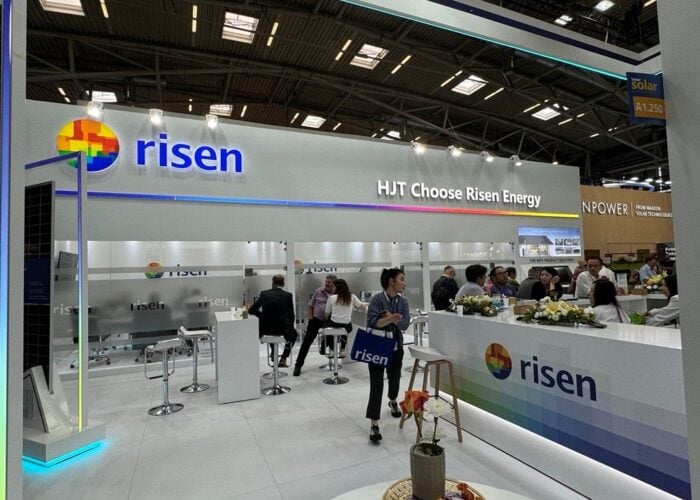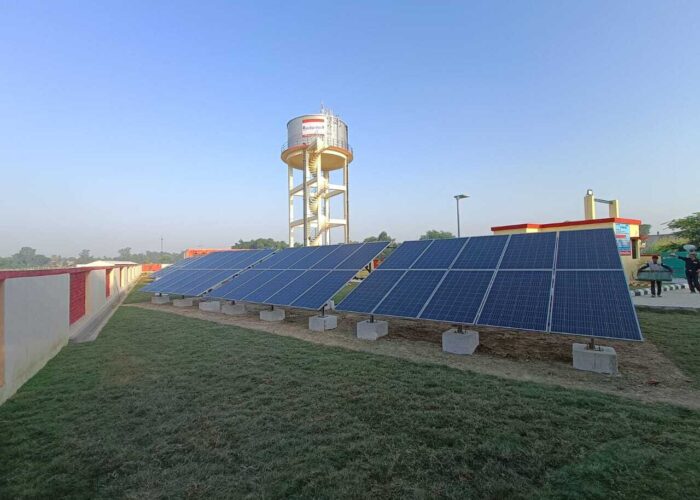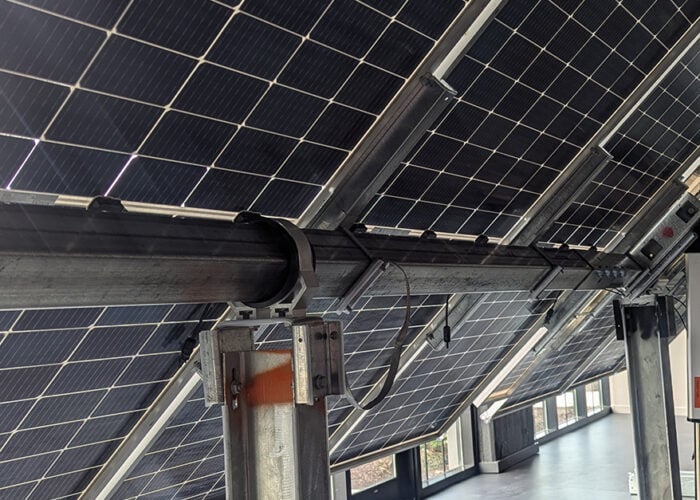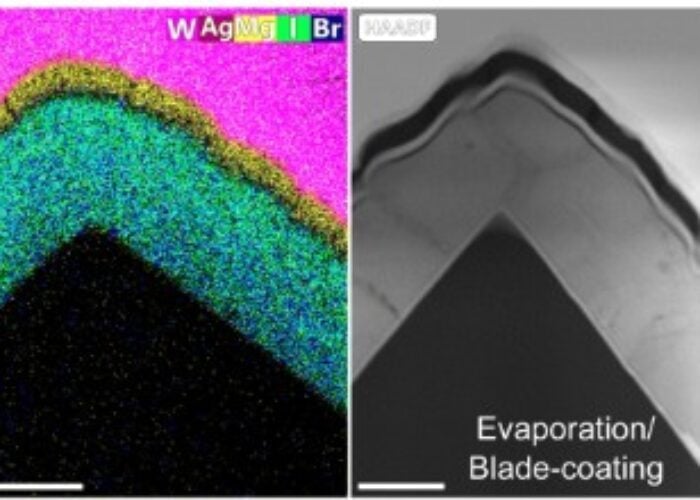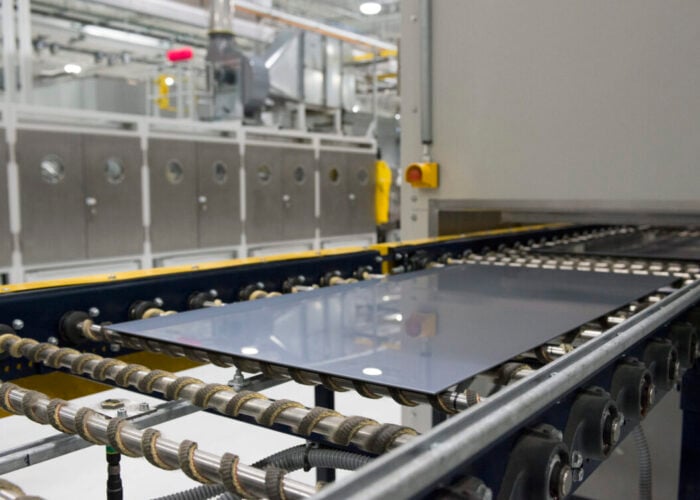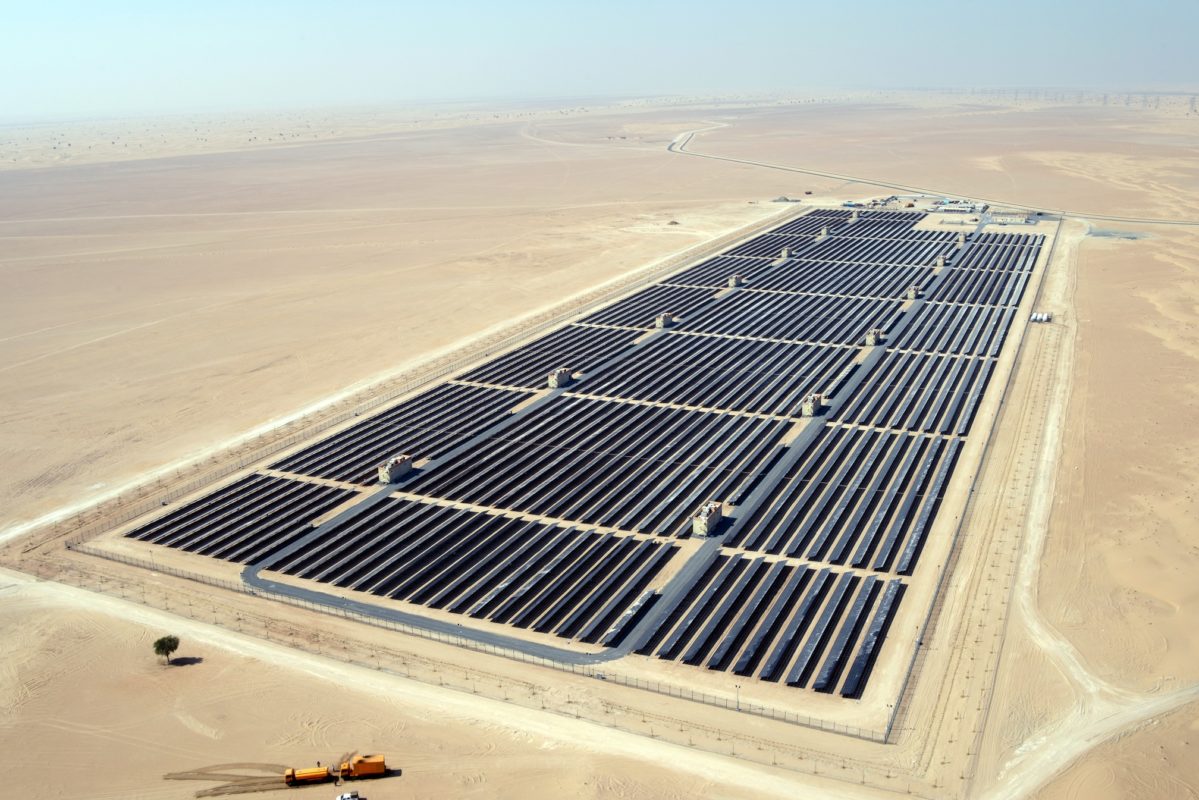
Generally, when something is too good to be true, it isn’t. The solar industry has had its fair share of false dawns. It could be technology breakthroughs that yield little but headlines, giant, unfundable project pipelines or start-ups touting the next big idea that will ultimately make little impact. The industry is also not short of big announcements that carry varying degrees of weight. Memorandums of understanding generate a collective groan in the PV Tech newsroom; there is no historical milestone, in the solar industry or outside it, linked to a memorandum of understanding.
Scepticism was perhaps an understandable initial reaction to the news that ACWA Power, the successful bidder in the 100MW PV tender in Dubai in late 2014, had tendered at under six US cents per kilowatt hour (5.84 cents/kWh). The project is the second phase in a series of solar tenders planned by the Dubai Electricity and Water Authority (DEWA). Since then, the project has been fully financed, the size doubled to 200MW and the price has been repeated (almost) in other markets, in the region and also in Texas.
Unlock unlimited access for 12 whole months of distinctive global analysis
Photovoltaics International is now included.
- Regular insight and analysis of the industry’s biggest developments
- In-depth interviews with the industry’s leading figures
- Unlimited digital access to the PV Tech Power journal catalogue
- Unlimited digital access to the Photovoltaics International journal catalogue
- Access to more than 1,000 technical papers
- Discounts on Solar Media’s portfolio of events, in-person and virtual
So can the project deliver on that low, low bid? Vahid Fotuhi of Dubai-based consultancy Access Advisory and a former president of the Middle East Solar Industry Association (MESIA) points to the industry’s reaction when the third round of DEWA tenders was released. In October, it was announced that 95 companies had expressed an interest in the tender.
“The fact that that the last project was around 5.5 cents has not dissuaded project companies from stepping forward,” says Fotuhi. “They may think ACWA Power took on more than it can chew and perhaps won’t be as aggressive in this round, but regardless, [the next phase is] 800MW, it’s one of the largest tenders in the world and many companies are going to at least come to the negotiation table and see what they can put forward. It is a very, very large volume and it is certainly worth having a go. Those that came just short in the last tender will be keen to sharpen their pencils and make sure they are successful in this round.”
The 200MW second phase of the Sheikh Mohammed bin Rashid al Maktoum Solar Park, named after Dubai’s ruler, represents one of a number of shifts in the Middle East market that suggest it might finally be ready to emerge as a serious source of PV demand. The winning consortium of Saudi power engineering firm ACWA Power and engineering consultancy TSK Group, had bid on the basis of using First Solar modules, a procurement decision it set out from the outset of the bidding process.
“The DEWA phase 2 project is a landmark for the region and has ignited a whole lot of discussion and excitement around the cost competitiveness of utility-scale solar PV in the region,” says Matt Merfert, technical director at First Solar. He notes that the victorious price is even lower than conventional energy prices, quite a feat in a region with heavily subsidised fossil fuels.
“[That’s] an important milestone and demonstration of the validity and applicability of the technology for this region. There are a lot of factors in how that very low tariff was achieved,” adds Merfert.
Money talks
One of the principal reasons is the financing that has been put in place to pay for the project. ACWA Power’s CEO has said that the overall cost will be US$400 million. He revealed that the project has a 27-year, US$344 million loan from Abu Dhabi-based First Gulf Bank and Saudi Arabia’s National Commerce Bank and the Samba Financial Group. The interest rate is 4%. For comparison, India is purring over a rate of 9.75% for industrial rooftop projects and Brazil’s development bank offers solar developers discounted loans at around 7-10% with a lower rate only available if strict domestic content conditions are adhered to.
Fotuhi expects Dubai’s 800MW tender to continue attracting competitive financial interest. “When we look at the previous tender with 200MW it was financed by Saudi and UAE banks and I suspect that round three will have much of the same. It is a bigger ticket so there will be some sort of syndication involved and several banks will be playing ball, local and regional and large commercials such as Standard Chartered and HSBC will be actively looking at these projects,” he says.
The right technology
Sgurr Energy acted as technical advisor on the deal for the syndicate of banks funding DEWA 2 and is more than familiar with the hurdles any project has to pass, let alone one with such a competitive price to live up to.
“DEWA’s 200MW development is a landmark solar PV project for the Middle East and, as well as driving down costs, it has put the region’s PV market on the global stage,” says Kevin Wilkinson, solar team leader at Sgurr Energy.
“One benefit of solar PV development is that the technology travels very well. Whether building a 5MW PV plant in France or a 200MW plant in Dubai, the technology is often similar and in many cases identical PV modules, inverters, transformers and mounting structure technologies are being used. This highlights the universal nature of PV design and is one important reason why we have seen such swift cost reductions for key PV components,” explains Wilkinson.
That’s not to say that the project development process as a whole is identical from one market to the next.
“The key challenge for technology providers in the MENA region is in working with new electrical grid codes,” says Wilkinson. “Equipment may be well tried and tested for the grid networks in established solar markets, but integrating a solar plant requires careful design and planning. This type of plant behaves very differently from the traditional power plants the electrical network will be used to. In our experience so far, we have seen technology suppliers perform very well in this regard, working closely with local grid companies to ensure that generated power can be reliably exported for the benefit of the consumer.”
There are further regional considerations to consider during the operation of the plant.
“Hot desert conditions create several unique challenges for PV development and stress the importance of technology selection when developing in the MENA region. One example is PV module behaviour, which is extremely responsive to changes in ambient temperature and irradiance,” explains Wilkinson.
“The enhanced performance of thin-film technology in hotter temperatures, when compared to crystalline panels, has been a key driver in the increased uptake of thin-film in the region. Tracking technologies have also come in to their own for deployment in climates of high irradiance. Sgurr Energy has calculated production increases of up to 16% for single-axis trackers compared to standard fixed-tilt systems, evidence which supports the move towards tracker technologies across the MENA region.”
First Solar was one of the first international manufacturers to establish a base of operations in the region and that early mover advantage is starting to pay dividends.
The project has ignited a whole lot of discussion and excitement around the cost competitiveness of utility-scale solar PV in the region
Goodbye technology risk
Unsurprisingly, First Solar’s Merfert backs Wilkinson’s assertions that thin-film modules are a smart choice in the region. The difference with his claim versus those that other vendors may make about their prospects in emerging Middle East markets is that it can back them up with in-the-field data.
“In terms of technology risk, this is a unique situation. We were able to put a 13MW plant in for DEWA phase 1, we were the EPC and are continuing to do O&M, and that has been in operation for two years now at the same exact site [as the 200MW and 800MW phases], so we have extremely high confidence in the detailed weather data and the module performance in that specific location. That enables us to give high-confidence energy projections into the project,” Merfert explains. “Those results show that we are outperforming the original expectations, DEWA has confirmed that, we’re well above the guaranteed and expected values and there is no issue with reliability.
“If you go back in history, the original 1GW park plan included a mix of PV, CSP trough and CSP power towers, but as this concept has evolved we have seen it go 100% PV for the first gigawatt which is a win for PV,” adds Merfert. The project is now targeting 5GW as part of the emirate’s increased renewable energy targets.
From an independent perspective, Fotuhi believes the sector’s growing body of experience in the region has now removed technology as a barrier to investment.
“I think technology risk has been pretty much nullified. DEWA and the other utilities have seen that solar works and, based on the large-scale systems that have been installed already, that production is not inhibited by dust, or haze or humidity. That has spurred them on to be all the more aggressive in the third round [of the Dubai tender]. For example, the first round was 13MW the second was 200MW, that’s almost 20 times larger and now it has gone from 200MW to 800MW. That shows you the confidence level both here in Dubai and across the region in Jordan, Egypt and elsewhere.”
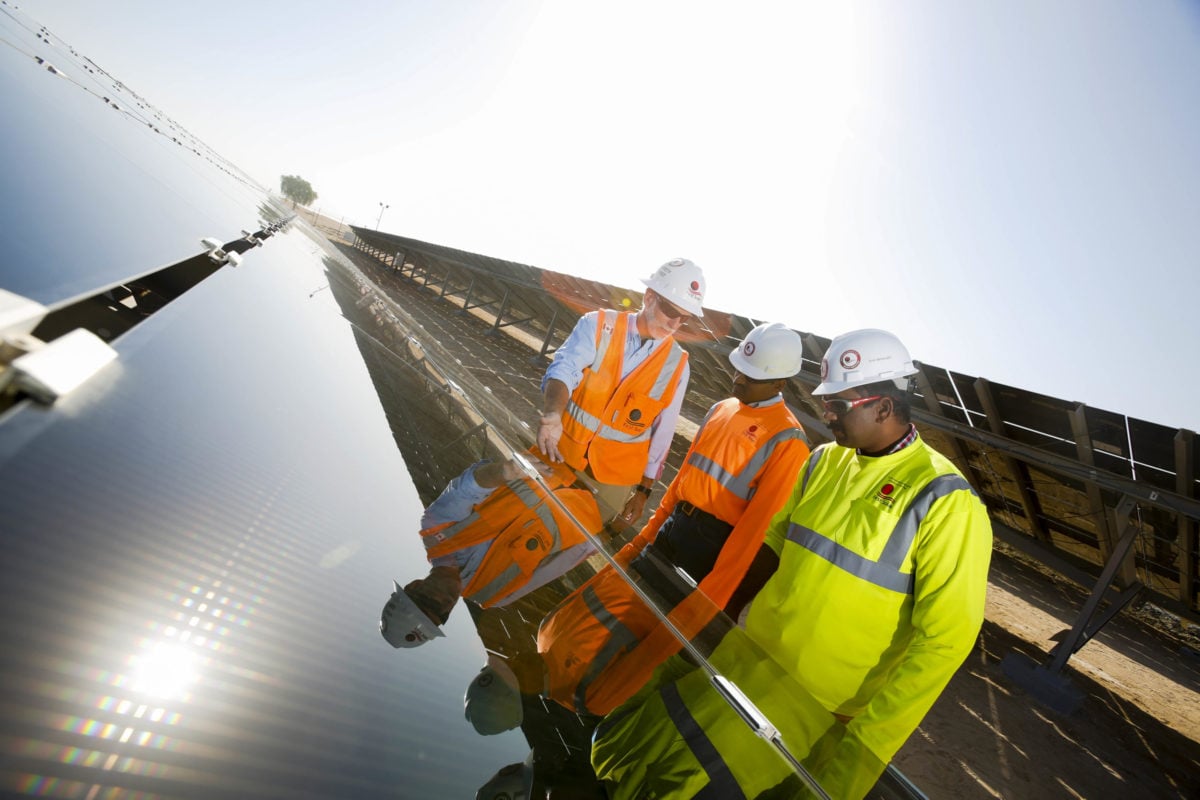
Operation
Fotuhi says that as much as technology risk has faded away, question marks surrounding the operation and maintenance of plants once they are complete have also “withered” meaning “developers and off-takers are now more bullish about solar”.
“I’ve seen the O&M team at the 13MW facility and it is all very streamlined, they have adopted innovations that allow them to clean solar panels without using water and using minimal labour,” says Fotuhi.
Sgurr’s Wilkinson confirms that cleaning was one issue high on his list of questions.
“PV module cleaning is one topic which has led to extensive discussion during our work in the Middle East. The irradiance conditions are often ideal for solar development, but it often comes with a shortage of rainfall. Combined with occasional sand storms, module soiling has the potential to impact project energy yield by up to 8% in just one day, so this quickly becomes a key consideration during the operational phase of any project in the region,” he says, describing the dry brush method used by First Solar as yielding impressive results.
It was an issue top of the list of considerations for Merfert.
“Number one in operations [in this region], something that is different from mature PV markets, is module cleaning. This is being overlooked by many developers; there is a lack of information in the market about soiling and the effect on energy production. The soiling rate in summer in Dubai can lead to 10% energy losses in a month if you don’t clean, and this is a business where people win and lose on half a percent.
“Cleaning is mandatory. We have a full-time manual dry cleaning programme in our O&M offering and we have developed a totally dry cleaning method that uses no water and is achieving very low soiling losses. This does come at an added cost,” he says, pointing out that developers and investors need to assess the case for cleaning carefully. But in the Middle East he considers it a “permanent, full-time mandatory requirement for the life of the plant”.
Confidence in the cleaning component of the O&M contract, two years of data from the 13MW test site and ACWA Power securing a 27-year loan at just 4% all make that 5.84 cents/kWh figure look perfectly normal. But Merfert explains that a high energy yield is a must to make the economics stack up.
“If you think about the equation for the levelised cost of electricity, it’s dollars divided by energy. So when you think about the module it is just a portion of the expenditure but it is responsible for 100% of the energy in any given plant, so I think the module is the most important component when you’re thinking about looking at a competitive LCOE,” he says, before issuing a warning for those that may consider the Middle East as an easy target now.
“I’m seeing a trend of European EPCs coming into the Middle East and bidding European numbers for EPC [services] and I think there are going to be a lot of surprises. As the Jordan round-two tender and Egypt’s FiT programme start to get to financial close, ground-breaking and execution you are going to see an awful lot of companies learning a lot of different lessons. It is very, very different here.
“People see the price achieved by DEWA and assume that you can achieve that price in Egypt or in Jordan but all of the conditions are different in every country. People just have to do their homework to get to the right numbers for these markets as they evolve. There is going to be a maturation period and a discovery period while the market finds its place,” adds Merfert. “The exciting thing is that that place is going to be competitive with conventional energy.”
This story orginally appeared in PV Tech's downstream magazine PV Tech Power, which you can read for free here.

